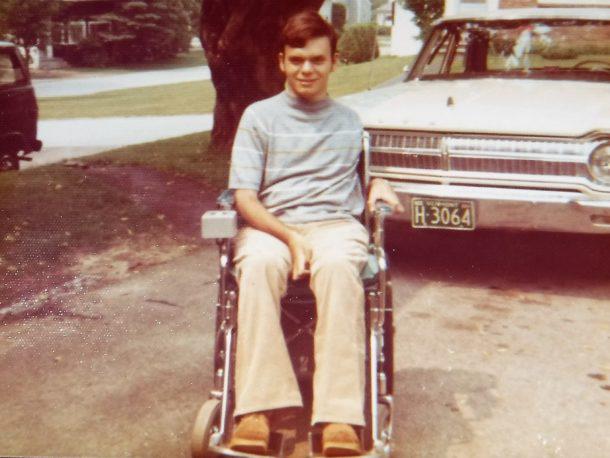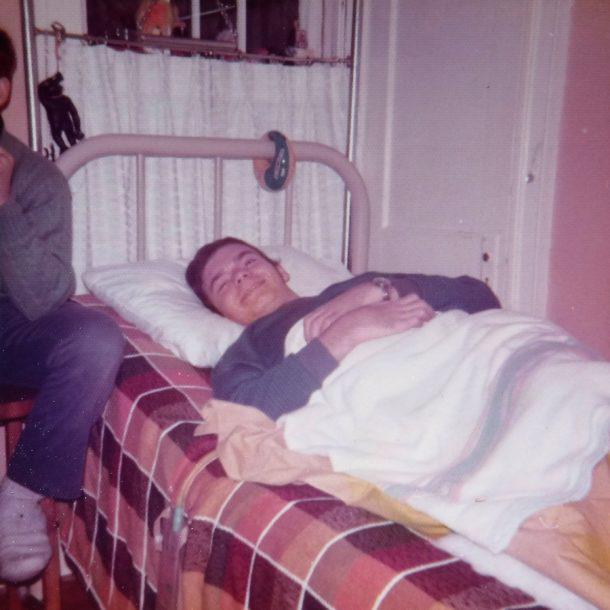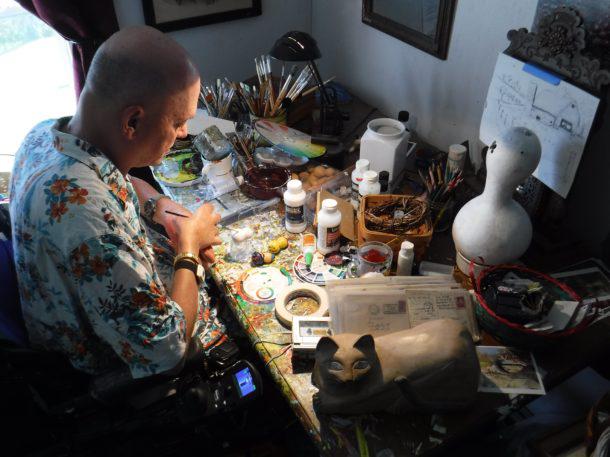|
One boy: How a Vermonter rose above priest abuse
By Kevin O'connor
Vermonter Dan Gilman was a 15-year-old free spirit when, climbing a tree lurching over a friend’s aboveground pool July 28, 1972, he leapt upward. “I imagined I was one of those cliff divers they show on ‘Wide World of Sports,’” the Rutland resident recalls. “In that split second, everything was light and sparkling.” Then it all came crashing down. Gilman felt his head snap into his chest upon hitting the shallow pool floor. Fracturing his spine, the teenager was paralyzed from just below the shoulders to the soles of his feet. “This is bad, this is bad, this is bad,” Gilman thought as he lay in a hospital bed listening to doctors give him a less than 1% chance of recovery. Feeling helpless, the boy accepted a priest’s invitation to receive a blessing. The stranger pulled a privacy curtain around the bed. A cleric’s hands hold healing powers, the adult said before placing a communion wafer on the boy’s tongue, followed by a kiss on his lips. “You will be cured,” Gilman recalls hearing, “and you will be a normal kid again.” The boy wanted to believe as the priest went on to undress him. “I closed my eyes and hoped to God it was true,” Gilman recalls. “I prayed that putting my faith in his hands, literally in his hands, would lead to great things for me.” That’s why the boy stayed silent about the subsequent two years of sexual abuse. “I didn’t want to stop believing he might cure me — that was how much I wanted my paralysis to go away,” Gilman says today. “All I knew for sure was that no matter what happened, I could never tell anyone.” Gilman, now 62, has since moved forward in a motorized wheelchair he steers with the muscle movement he retains in his left bicep and shoulder. Equally skilled with a computer, he has followed news of separate investigations by Vermont law enforcement and church leaders into the Roman Catholic Diocese of Burlington’s half-century history of clergy abusing children. The state’s largest religious denomination recently acknowledged it knew of credible accusations against at least 40 Vermont priests over the past seven decades but did nothing to alert the public or police. “While most of these allegations took place at least a generation ago, the numbers are still staggering,” Vermont Catholic Bishop Christopher Coyne said upon release of an online report. “The victims of these priests are still bearing the wounds of what happened to them.” The priest who abused Gilman has a personnel file some 300 pages long. Hidden for nearly 50 years, the paperwork tells of dozens of incidents in the cleric’s home state of Massachusetts, his next assignment in Indiana and Vermont transfers to Rutland in 1972, Montpelier in 1974 and Burlington in 1976. Gilman’s story isn’t among them. It’s one of an unknown number still to be told. ‘He told me he and the Lord would cure me’Gilman, the oldest of four boys in a churchgoing, working-class family, grew up testing limits. He wasn’t afraid to catch snakes. Sneak beer. Throw bullets into a bonfire. Dive headfirst into an inner tube floating atop a 4-foot-tall pool. “Everything was more peaceful and quiet than I’d ever felt,” he recalls of the moment hot air gave way to cold water. “The world turned blue and soft and silent. I floated in the clouds.” That’s when friends, seeing Gilman limp and sinking, pulled him from the pool. “I couldn’t feel their hands,” he recalls. “I couldn’t feel anything.” Gilman could only see his parents’ frightened faces, hear the ambulance siren, taste the wet swab wielded by the hospital nurse who said he’d have to wait for the doctor to answer his questions. Soon came whispers in the hallway, worries of lung and kidney infections and bedsores, the words spoken when everyone thought he was asleep: “Life expectancy, at best, around nine years.” Gilman had thought the worst was not being able to walk again. Now no one believed he’d live to age 25. The teenager was despondent. Then the Rev. Edward Paquette entered the hospital room. The new priest at Rutland’s Christ the King Church offered a communion wafer, a prayer and an uncomfortable kiss. Gilman still remembers the lingering feel of Paquette’s five-o’clock shadow and smell of sweet pipe tobacco and hair cream. “I thought his visit was a little freaky,” Gilman recalls, “but I chalked it up to something I’d never experienced before — the power it took for priests to heal the sick.” Days later, the boy woke to find Paquette back at his bedside. The privacy curtain again was closed. This time, his pajamas were open. “Good morning,” he recalls the priest saying. “I’m here to give you the Lord’s blessing.” Gilman kept quiet as Paquette touched places the paralyzed boy couldn’t. “He told me he and the Lord would cure me, and I needed to be patient because the Lord worked in mysterious ways.” The “healing sessions” morphed from kissing and touching to masturbation, oral sex and ultimately intercourse in locations that ranged from the hospital to the boy’s home to a camp on the Maine coast. “I felt all twisted up inside,” Gilman recalls. “I knew what we were doing was wrong, but I didn’t want to stop. If we did, what would happen to the recovery he’d promised me?” At least someone was trying something, the teenager reasoned as doctors announced there was nothing more they could do. “I didn’t have a choice since the world of medicine had failed me,” he thought. And what could a boy in a wheelchair say or do to stop the priest’s advances? Who’d believe him if he told? Would “the neighborhood’s toughest guy” be branded a girl? “My father paid little attention to Father Paquette’s frequent visits, other than to thank him for helping out,” Gilman recalls. “But the women in my family fawned over our resident holy man. They said I was quite blessed to receive so much attention from him.” The abuse continued for two years. Then, suddenly, Christ the King Pastor James Engle arrived. Days earlier, Engle had written then Vermont Catholic Bishop John Marshall to report the discovery of Paquette molesting two other boys while on communion calls at the hospital. “As you readily understand, it is imperative that Fr. Paquette be removed from the Rutland area immediately,” Engle said in a private letter to the bishop Oct. 21, 1974. “I would suggest also that since his removal from the parish must be done quickly, it should be done without fanfare and farewell parties and that it be publicly announced as a sick leave.” But the pastor didn’t tell Gilman or anyone else that. ‘It’s still with you — it’s how you deal with it after’Instead, Engle simply said, “He moved away.” So would Gilman. He visited a rehabilitation center in Virginia and learned how to finagle a faucet handle, washcloth and electric toothbrush. Then a brute of an orderly, purposely injuring the teenager with bandage tape, sent him home and back into the hospital. The resulting years repeated the pattern: Two steps forward, then one back. Yet slowly but surely, Gilman went to college in the 1980s. Went to work in the 1990s. Went online with the start of a new millennium. Gilman types by prodding a hand into his wheelchair’s mechanical arm and pecking the keyboard with a finger-shaped attachment. “I can’t move my arms, hands or fingers,” he says. “I move my shoulder muscles.” He practiced in an internet chat room. “Hi,” he typed one day. A woman responded. Her name was Meredith, the screen said — Meredith Kelley, a nursing home worker from North Carolina. The two typed for weeks, then talked on the phone for months. Gilman mailed Kelley a plane ticket to Vermont for Thanksgiving 2002. Just before her return flight, he took her to a jewelry store and asked if she wanted a ring. She has lived with him ever since. Then again, the story isn’t as simple as “and they lived happily ever after.” Kelley realized Gilman couldn’t legally marry so not to lose his attendant-care benefits. But she didn’t understand his unexplained mood swings as the Vermont press, following the lead of a 2002 Boston Globe investigation dramatized in the Oscar-winning film “Spotlight,” began unearthing a nearly half-century history of clergy abusing children. By the time Gilman shared his past with Kelley, he discovered more than 30 Vermont men were suing the diocese for negligence in hiring and supervising Paquette. “I don’t know if that is a comfort or a horror,” Gilman thought of the fact he wasn’t alone. Gilman pursued criminal charges in 2011, only to find prosecutors stymied by too little physical evidence and too much time having passed under the statute of limitations for filing such cases. “Unfortunately, I am unaware of any law or decision which transmutes the horrific betrayal this priest is alleged to have committed into a cognizable crime we can prosecute today,” the Rutland County State’s Attorney’s Office concluded. “Given what you have told me about this case, all I can say is I am sorry.” But Gilman could and did file his own civil lawsuit against the diocese in Burlington’s Chittenden Superior Court. His case was one of a dozen resolved in a 2013 blanket settlement that Vermont’s Catholic Church hoped at the time would cap a then 11-year, more than 50-lawsuit saga. Gilman agreed to the terms on two conditions. First, he wanted a copy of Paquette’s personnel file, which details everything that led to his official removal from the priesthood in 2009. And second, “I wanted the freedom to tell what had happened.” And so, hunting-and-pecking one letter at a time, Gilman has typed every horrific, haunting memory into a life story he titles “The Blue Hole,” referring to both a favorite childhood fishing spot and his spiraling, seemingly inescapable adult emotions. “If I had left it as a story of a spinal cord injury,” he says, “people would have seen it as inspirational but not recognize the severity.” Gilman can tell you about the heartache and guilt of the two women who felt most responsible for his paralysis. The first was his late mother, who cared for his most personal of hygiene for 22 years until her death from brain cancer. The second was her friend whose pool he dived into. Blaming herself, she walked into a closet one day and hung herself. Neither woman ever knew about the subsequent abuse. Gilman also can talk about his own battles with sadness and shame, anxiety and anger, depression and delusion. Many times he has drifted off to sleep imagining how he’d adapt his wheelchair’s mechanical arm so he could shoot and kill Paquette, now 90 and retired in Massachusetts. One day, Gilman began planning for real. Obtaining a federal firearms license to start a gun and ammunition business, he ordered “dozens and dozens” of weapons, worked with a gunsmith to craft a metal trigger finger he could operate despite his disability, and practiced shooting “thousands upon thousands” of rounds of ammunition. “I refused to wear ear protectors,” he recalls, “because my body had to hear the power I held in my hands.” By then Gilman was seeing a psychotherapist for post-traumatic stress disorder. He told her about his desire for justice. She redirected his feelings into safer outlets. “A gun couldn’t define me as a man any more than being able to walk could,” he says today. “Being a man was something deep in my heart and had to do with being a strong and honest person.” To support that, Gilman has found calm and comfort through EMDR (eye movement desensitization and reprocessing) treatment as well as encouragement to pursue his hobby of creating art. Tour his home and you’ll find the walls covered with his handiwork. “I found painting on canvas to be difficult,” he says. That’s why Gilman, aided by his wheelchair’s mechanical arm, has turned his brush to the dried gourds hanging over the dining room table. The statues on the lawn. The wheelchair ramp outside his house. “It’s a very slow, meticulous process,” he says, “which in itself is meditative.” Gilman still follows news of the decades-old priest misconduct only now being discussed and dealt with worldwide. He knows the headlines won’t go away anytime soon. But every moment he focuses his mind and movement on painting, dark thoughts of the past give way to a brighter outlook in the present. “People assume once you go to court or get a settlement, everything goes away,” he says. “It doesn’t. It’s still with you — it’s how you deal with it after.”
|
.
Any original material on these pages is copyright © BishopAccountability.org 2004. Reproduce freely with attribution.




